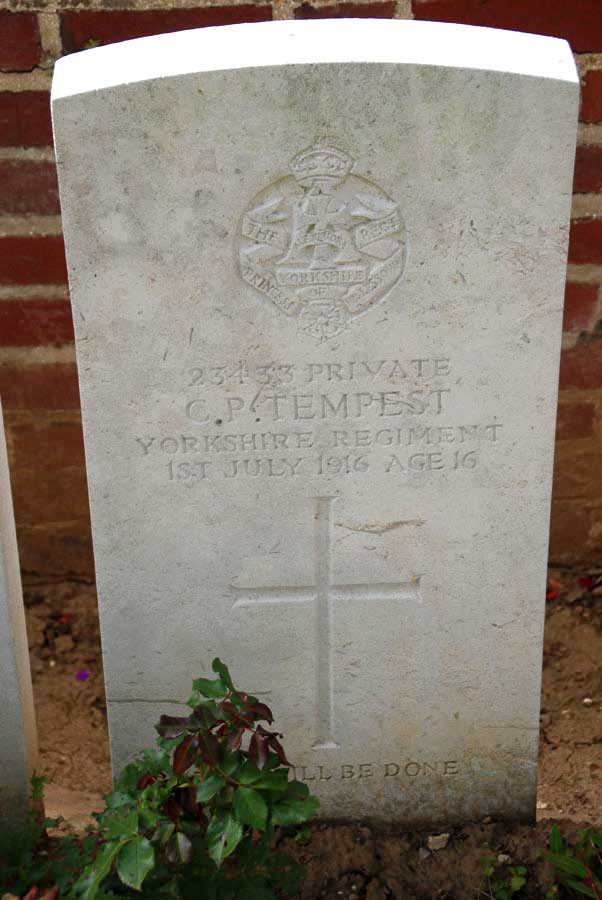
Researched by Paul Gayton.
Private Tempest was in the 2nd Battalion of the Yorkshire Regiment and he was killed on the 1st of July 1916 (the first day of the Battle of the Somme) aged only 16 years of age. We believe that he is the youngest army fatality commemorated on the memorial in Friary Gardens.
He was born in Richmond and his birth is registered in the 3rd quarter (July to September) 1900, so it is possible he may even have been 15 when he was killed.
His parents were Thomas and Emily Annie Tempest. He had 3 older sisters, Edith Rose, Florence Ruth and Emily Ann. Also he had an elder bother Frances William. The family lived in nearby Sleegill where his father worked as a paper maker. The paper making industry on the river Swale existed in Richmond from the 1700s but ended in 1931.
Charles Percy enlisted on the 22nd of August 1915 and was initially posted to the 3rd Battalion. In 1916 he transferred to the 2nd Battalion for active service in France. He is buried at Danzig Alley British cemetery at Mametz and his name is among the others that are commemorated in Friary Gardens.
Explore more memories from the ribbon
-
Major Charles Organ
Photographic research by Stuart Hodgson. Charles Organ had a long career in the army before arriving at Richmond Depot and acting as Recruiting Officer during the First World War, as his record from our museum catalogue recounts: Born at Woolwich 13th October 1853. Charles Organ joined as a Private 13th January 1873, Corporal 11th October 1873, Sergeant 15th August 1874, Colour Sergeant 27th August 1875, promoted to RSM on the 20th April 1882 and QM 1883, Hon. Captain 8th August 1893, Hon. Major 29th November 1900. He served in Bermuda, Halifax, Malta, Egypt, Cyprus, Egypt, Gibraltar and South Africa. He was employed as the Regimental Transport Officer 12th Dec 1900 – Sept 1902. Retired on 1st September 1902 but was then appointed QM the Royal Hospital Chelsea October 1903 – 1st September 1912, Created a MVO by King Edward July 1905. He served in the Nile Expedition 1885, Sudan Frontier Force, 1885-6, Boer War 1899-1902 including operations around Colesberg, actions at Paardeberg, Kitchener’s Kop, Proplar Grove and Drifontein and the occupation of Bloemfontein, was with the advance on Dewetsdorp, and action at Leuukop, in the march to Pretoria, actions at Brandfort, Kroonstadt, Vet and Zand rivers, and Johannesburg: took part in the advance eastwards, including the battles of Diamond Hill and Belfast – mentioned in despatches. He served with the Depot between August and November 1914 and then appointed as Staff Recruiting Officer in December 1915 becoming the Sub Area Commander for Gosport on the 19th February 1916. Died at…
-
Driver John Marwood
Submitted by Peter Marwood, a long term resident of Richmond. I was brought up on my late father’s farm in Langthorne near Bedale. Driver John Marwood 671397 of the 379th Battery, Royal Field Artillery was my father’s brother and my uncle. John Marwood was born at Gayles near Richmond on the 16th of May 1890. He was the second of four children of John and Caroline Marwood. The family initially lived at Gayles where John senior was self employed as a master carpenter. By 1901 the family had moved to a rented farm at Aske Moor and began farming. After a few years they moved to a larger and better farm which was Low Coalsgarth farm. John is listed in the 1911 census as working as a gardener at Selaby Hall near Gainford. The family were living at the farm at the time of John’s death in France. He was wounded on the Somme during the famous Kaiserschlacht offensive which began on the 21st March 1918. My father and his other brother Harry recounted that John had been badly wounded at the Front and was taken to hospital in Rouen but sadly died of his wounds on the 25th of March 1918 aged 28. He is buried in the St Sever cemetery in Rouen. During the 1950s my father would usually attend the Great Yorkshire Show, along with my Uncle Harry and one older brother and if we were lucky myself or my younger brother would get to go too….
-
Gardner Kennedy
Helen Bennett visited the museum to tell us about Gardner Kennedy. (William Robert) Gardner Kennedy was my paternal Irish Grandmother’s first cousin. He was the son of Mary and William Kennedy of Ardbana House Coleraine, Northern Ireland. His father had an engineering firm. He was my Irish Grandmother’s cousin. (Annie Morton McMillan of Turnagrove Co Antrim) There is a very strong familial likeness between Gardner Kennedy and his Turnagrove cousins, most of whom I knew. Gardner Kennedy died on the Swaben Redout on July 1st 1916 which is where his regiment the Royal Iniskilling Fusiliers fought Reg no:18637. Lance Corporal, Machine Gun Corps (Infantry) 1st Battalion Royal Inniskilling Fusiliers. He has no known grave and is remembered on the Thiepval Memorial, and on the Coleraine War memorial, although on the latter his Christian name is incorrectly spelt. He enlisted on 5th October 1915. His brother, Lieutenant John Alexander Kennedy, survived the war. However further tragedy struck the family on 2nd March 1917 when the Kennedy family lost their only daughter, Mary Boddie, wife of Geoffrey W Boddie. Comment: About 1959 or 1960 I visited Edie Kennedy who (I presume) was Gardner Kennedy’s sister law at Ardbana House, a splendid detached house full of faded elegance. I met Jack, Edie’s son who was a wild child, liked building his own racing cars. Of Edie, I remember only a little old lady, shrunken but lively, sitting regally amongst the faded and cluttered Second Empire furniture in front of a huge fireplace with…
